The Abbey School, Tipperary
An Extraordinary History
A Unique School
An Extraordinary History
1 The Augustinian Connection
At the bottom of a hill, beside a river bank a friary was founded around 1300 by Augustinian Friars, who arrived in Ireland twenty years earlier and went on to establish houses across the country, including Fethard, which was established from Tipperary. In the Middle Ages, Tipperary all but lost its civic identity and the presence of the friars beside the Ara, helped keep the settlement alive. The friary church served as parish church. The only information available is the name of the last prior, Denis O’Quirke, a local man, who surrendered the property to the state around 1540.
The loss of their property did not mean that Augustinian friars disappeared from the town. Amazingly, priors continued to be appointed and friars continued their work in the area. The Great Famine saw a tradition lasting five and a half centuries end. Fr Nicholas Roche, one of the last friars in Tipperary, died in 1847 and lies buried in the grounds of St Michael’s church.
Apart from the ruins of the friary, one part of which, an arch, survived until the 1950s, there was a small amount of land near the town and across the river, some building plots. The abbey and its land were leased to a Ryan family from Solohead, who held on to it for four generations, until, along with so many others, they lost everything in the 1640s.

2 Erasmus Smith (1611-1691)
Rebellion broke out in Ireland in 1641 and in less than a decade, the king was dead, Parliament and Cromwell were in control and a new order was imposed on the country, which conveniently allowed supporters to be rewarded with Irish land. Erasmus Smith, a London-based merchant from a Puritan background, member of a family who supported Parliament during the tough years, increased his own land grants by buying up, cheaply, other people’s grants. Many individuals did not relish the prospect of coping with land in Ireland. Smith ended up with around 34,000 acres in eleven counties.
In volatile political and religious circumstances, the monarchy being restored in 1660 and a more mainstream form of Protestantism coming back into favour, someone like Smith, having gained much, had to be careful. In 1657, when Cromwell was still in control, Smith began the process of setting up an educational charity. Not until the charter of 1669 was his educational charity both formalised and secure. Some of his land in several counties was set aside to fund this, including 4.279 acres in Limerick, 2,903 acres in Tipperary (which included Soloheadbeg) and 1,585 acres in Galway. The total endowment was 10,467 acres. Rent from the tenants on this land would support grammar schools, established eventually at Galway, Drogheda and Tipperary.
Who was to benefit from this charity? In later centuries, this question was endlessly debated. Smith was interested in the provision of religious based education, not least for the sons of his tenants. His assumption was that these would be Protestant, though exactly what kind of Protestant is unclear. By the nineteenth century, most of the tenants on what had been Erasmus Smith lands, were Roman Catholic. By then, Smith’s educational charity was seen as part of the Church of Ireland.

by George White, after Unknown artist, mezzotint, early 18th century
3 The Tipperary Grammar School
Sometime in the 1670s, the first of what would be a sequence of four schools was built beside the River Ara. The ruins of the Augustinian abbey were demolished and the stones used in the building of a grammar school with residential accommodation, located farther back from the river than the old abbey. An arch from the old abbey was left standing, as a memorial to the past. In July 1693, during the Williamite Wars, the town was attacked, during which the school was burned. Nearly a decade passed before a new school was built; this time, one that lasted for over a century.
Smith’s education charity depended on income from the estates set aside for the purpose and for the first forty years or so, Joseph Damer of Shronell managed the property. That he died, reputed the richest man in Ireland, owning for example, the parishes of Cullen, Bruis, Lattin and Shronell, suggests his own interests came first.
The governors of the charity met in Dublin and consisted of influential figures in religion and politics, all members of the Church of Ireland. Down the country, headmasters were appointed and left to get on with their schools, the success or otherwise of a school totally depending on the head’s character and ability. Pupil numbers were small. In the mid-1730s, there were 30 boys in the Abbey; a name that appears to have been in popular usage from early days.
In the second decade of the 19th century, a new school with accommodation for up to a hundred boarders, was built. This ambition was ahead of reality. While the school was Church of Ireland, it sometimes employed Roman Catholic teachers to encourage Roman Catholic pupils; for example, Michael Slattery at the end of the eighteenth century (archbishop of Cashel & Emly, 1833-57); John O’Leary (Fenian) some decades later and Thomas St George McCarthy (founder of the GAA) in the 1870s. Just before the Famine, pupil numbers collapsed and the school was temporarily used as a military barracks.

4 Fr. David Humphreys (1843-1930)
On Thursday 13 Oct 1887, everything changed and nothing changed. Everything changed because Fr David Humphreys began his involvement with the Erasmus Smith educational charity; nothing changed because for a long time, he was a voice in the wilderness. Humphreys was a curate in Tipperary 1885-1895 and is now remembered for his role during the Plan of Campaign and the building of New Tipperary. He was a native of Murroe and from 1895 to his death, he was parish priest of Killenaule.
The exercise of control from beyond the grave is always problematic. The charity, as established in the late 17th century, reflected the values and attitudes of that time and did not have a window on the future. Long after Smith’s death, the trustees in charge of his charity did new things like funding hundreds of small primary schools across the county; they established a grammar school in Ennis (1775-1891) and of most significance, a new second level school was opened in Dublin in 1870, The High School, in Harcourt Street. A hundred years later, this school moved to its present campus in Rathgar.
Fr. Humphreys agitated and argued that the Erasmus Smith charity had improperly become the preserve of the Church of Ireland, to the detriment of Roman Catholic boys, whose families were tenants on Smith’s original estates and for whom, Humphreys argued, the charity was set up. Humphreys studied and wrote about Smith, his life and times and became something of an expert on the period. His efforts to have the question decided by the courts, failed.
In 1922, just as happened in the 1840s, the Abbey was occupied by soldiers, this time, not British but Free State. By then, students had been sent to a Waterford school, as a temporary measure. When the school was handed back to the charity, it was not re-opened. In a new Ireland, with new educational needs, the trustees of the Erasmus Smith charity had to rethink their priorities. The Drogheda school closed in 1938, as did Galway grammar school, twenty years later.

5 The Erasmus Smith Endowment Association
A new Ireland prompted a new beginning and to that end, in 1928, the trustees of the Erasmus Smith charity sought an act of the Oireachtas to change their constitution. The publicity around this move, triggered a renewal of the campaign for a Roman Catholic share of the charity. On 6 July 1928, a meeting of Tipperary urban council called on all interested parties, representatives from those areas where Smith had estates, to organise and campaign. Fr. Humphreys, now eighty-five, was not directly involved but in letters to the press, made the Roman Catholic case. At a meeting in Dublin City Hall, on 20 September 1928, the Erasmus Smith Endowment Association was formed. The following day, a deputation was received by the Minister of Education, who made noises not amounting to action.
A Dublin priest, Fr Myles Ronan (1877-1959) replaced Humphreys as champion of the Roman Catholic case. He spent months researching the background and in London, found documents used to support the case being advanced in the interest of Erasmus Smith Roman Catholic tenants. In 1931, the case was heard in the High Court, Fr Ronan’s evidence being vital in advancing the Roman Catholic case. Judgement was that the provision of education mattered more than religious identity, which meant that boys in and around Tipperary were entitled to benefit.
The trustees of the Erasmus Smith charity appealed this decision to the Supreme Court, a process that dragged on for several years. Behind the scenes and to avoid huge legal costs, the two sides reached a compromise and in April 1938, an act of the Oireachtas was passed. Funding of the Erasmus Smith schools no longer depended on rent from land, as all this land had been sold to its tenants, including in 1919, Sean Treacy’s farm at Soloheadbeg. This purchase money and the four existing schools (Tipperary, Dublin, Drogheda and Galway) were divided between the two sides. The Tipperary school and half the funds were to satisfy Roman Catholic claims and were vested with the Minister of Education; the other three schools and half the funds remained in the hands of the Erasmus Smith trustees.

6 An Old Legacy & A New beginning
Having been closed for twenty years, the issue was: in what circumstances would the Abbey reopen? Different plans were advanced but the Christian Brothers, in Tipperary since 1868, had a practical advantage and the weight of public support. Their existing secondary school, an old fever hospital on the Hills, was obviously inadequate. Not without opposition, in March 1939, the Christian Brothers were asked to take over the Abbey. Classes had hardly begun, when in November 1941, a fire badly damaged the building, though parts of it continued in use.
The Abbey was never owned by the Christian Brothers. It remains vested with the Minister for Education and is leased for one shilling per annum to those who operate the school. Arising from the Erasmus Smith Schools Act (1938), the relationship between the Department of Education and the Abbey was outlined in the Erasmus Smith Schools Act Scheme (1941). The Abbey’s emphasis on agricultural education would be funded, as would Erasmus Smith scholarships, paying for secondary education, not free at that time.
Over the following decades, it suited the Christian Brothers to ignore the Abbey’s history as an Erasmus Smith school and it suited the Department of Education to forget about the school’s special provisions. Fortunately, in the 1990s, a third champion (following Humphreys and Ronan) of local rights appeared. Mrs Maureen Gleeson, member of the board of management, began a campaign to have the Department of Education honour the agreements of 1938 and 1941 and pay the school what was due. She was eventually successful and the Abbey continues to benefit from its special status as an Erasmus Smith school.
On 24 February 2000, President Mary McAleese unveiled a memorial at the Abbey, celebrating the diverse nature of the Abbey’s history.

A Unique School
With respect to history and location, but not ethos and tradition, the Abbey School connects the 21st and 17th centuries.
The Augustinian presence in Tipperary lasted for over 500 years, around half of which related to the site beside the Ara. In that same space, a tradition of education has endured for nearly 350 years.
Today, The High School in Rathgar continues the Erasmus Smith educational legacy but that school is relatively new. The schools in Drogheda, Galway and Ennis are long gone. Only in Tipperary, is the work of education continued on the same historic site.
In its first manifestation, Tipperary Erasmus Smith grammar school opened as a result of the final conquest of Ireland in the 1650s and closed in the early 1920s, as a result of the partial undoing of that conquest.
The present school is the fourth school building on the site:
- The first from 1650s to 1691 when it burned.
- The second from c.1700 to 1820 when it replaced.
- The third from c.1820 to 1941 when it burned.
- The fourth from 1955 to present, with additions.
The Abbey in its present manifestation, is a result of the popular and legal campaigns by the
Erasmus Smith Endowment Association, founded in Dublin in Sept 1928.
The present school is a result of a complicated legal process, lasting several years.
The present school is a result of an act of the Oireachtas, the Erasmus Smith Schools Act, 1938
Tipperary Abbey school was handed over to the Minister for Education, together with half the funds (in today’s terms, perhaps €5m).
The Abbey remains in the hands of the Minister. It was and is leased from the Minister, for one shilling per annum.
A new academic subject was created, Agricultural Science, with the Abbey in mind.
This was first examined June 1944. The only students taking the papers were Abbey boys.
On three occasions, the Abbey was occupied by soldiers: during the 1690s, the 1840s and the 1920s.
Five individuals, who in very different ways, had a huge impact on how Irish identity is understood, were educated at the Abbey.
John O’Leary (1830-1907) Fenian and mentor to W.B. Yeats.
Standish James O’Grady (1846-1928) is known as the ‘father of the Irish Literary Revival’.
G.H. Orpen (1852-1932) was the historian who defined the Norman impact on Ireland.
Thomas St George McCarthy (1862-1943) was a founder member of the GAA.
Nicholas Mansergh (1910-1991) was author of the seminal The Irish Question 1840-1921.
In September 2018, Dr. Denis G. Marnane gave some very interesting lectures to the Transition Year students of The Abbey School to inspire their art projects that year which you can view below:


